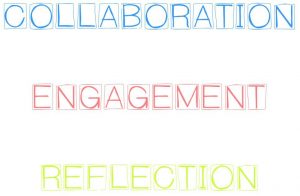

Greetings fellow friends of Guided Inquiry Design! My name is Sarah Scholl and I am a school librarian at Havre de Grace Middle School in Havre de Grace, Maryland! This is my second round of blogging (original postings 1, 2, & 3) for the GID blog and I am excited to add to the amazing postings which have already been added this year.

Mary Gargano, Sarah Scholl (Me), Anni Obenshcain & Sarah Wein: Curriculum Award Winners
I got started with Guided Inquiry when I first attended AASL in 2015 and learned about this research model as well as the CiSSL summer institute. I then attended the 2016 summer institute to design and develop a GID unit and began implementing our Challenge and Change project that fall. Our planning team submitted our Challenge and Change project for the county wide curriculum awards that year and we won!
However, it really is not how I got started that is most important, but rather, why I have stuck with this model for the last three years. As a school librarian, I have encountered multiple research models, but it is the GID model which has brought the most success for my students. There are three components which I feel make this model stand out against the rest: collaboration, engagement and reflection. My goal is to address each of these aspects in my postings this week.

For school librarians to be the most effective, they should be collaborative in their planning and instruction. This is one facet which GID reinforces as a crucial part of the process. A first step in planning for GID is to identify the team, which is meant to include a school librarian. It is explicitly stated that a school librarian be involved in the planning since this is a research process and librarians are research experts. It is truly in the best interest for both the teachers and the students to have a librarian involved, who can curate information, guide students through the exploration, identify and gather phases as well as provide support as students begin to learn how to do those things independently.
![]()
But, collaboration can be a challenge. With differing class schedules, meetings, etc., TIME can be the biggest barrier to doing honest to goodness team planning. However, when you take the time to make it happen, it is worth every spare minute you were able to devote to the work you are doing and in the end it benefits all parties involved. Ideally, you would have a half day or even a whole day to sit down and plan, but that is not the reality!
So how do you start? As a librarian, I often begin with an email or quick hallway chat to gauge interest. From there, I often jot down ideas and try and plan a time when we can have a quick chat about whether we are headed in the right direction. I also make sure I am familiar with the content teacher’s curriculum so I can reinforce the ultimate goal of “not creating more work” and show him or her where this can potentially align with what may already be happening instructionally.
After that, I try and schedule at least one hour of time to sit down together with the planning team to generate a rough outline, starting with the GID steps and what students will learn in each step. We develop a goal or objective and set up the outcome or student product. Often the conversation will include some backwards planning, thinking about what the end product may be; even if the end product is something simple, with more of the focus falling on the process itself.
Finally, we divide and conquer, each taking the portions we are responsible for and developing the daily lessons which will be taught. There will be the occasional hallway chat or five minute catch up time where we share what we have excitedly created, but more often than not, we rely on collaborative technology like shared Google drive or Office 365 folders, OneNote or regular old email to maintain our collaborative conversation. Then we check in the day before to make sure all is prepared prior to the first lesson and we continue the daily conversations, making small modification as we co-teach through the GID model. Now, I do use that co-teach term to represent just about every form of co-teaching you can imagine with this process. Sometimes we are co-lead teachers, sometimes I lead, sometimes the classroom teacher leads, it all depends on what is decided beforehand but, more often than not, the person who designs the lesson leads and then the other assists until they become comfortable with the material and is okay with stepping in to co-lead.
This is by no means, the only way to work through the difficult process of co-planning or working collaboratively with the GID model, but hopefully it will be some reassurance that it can work, even with the most time strapped teachers!
Cheers,
Sarah
Havre de Grace Middle School
Havre de Grace, Maryland
How do you manage time so you can co-plan using the GID model?
Previous Postings
https://52guidedinquiry.edublogs.org/2016/02/01/in-good-company/
https://52guidedinquiry.edublogs.org/2016/02/04/lets-start-at-the-very-beginning/
https://52guidedinquiry.edublogs.org/2016/02/06/wrapping-it-all-up/